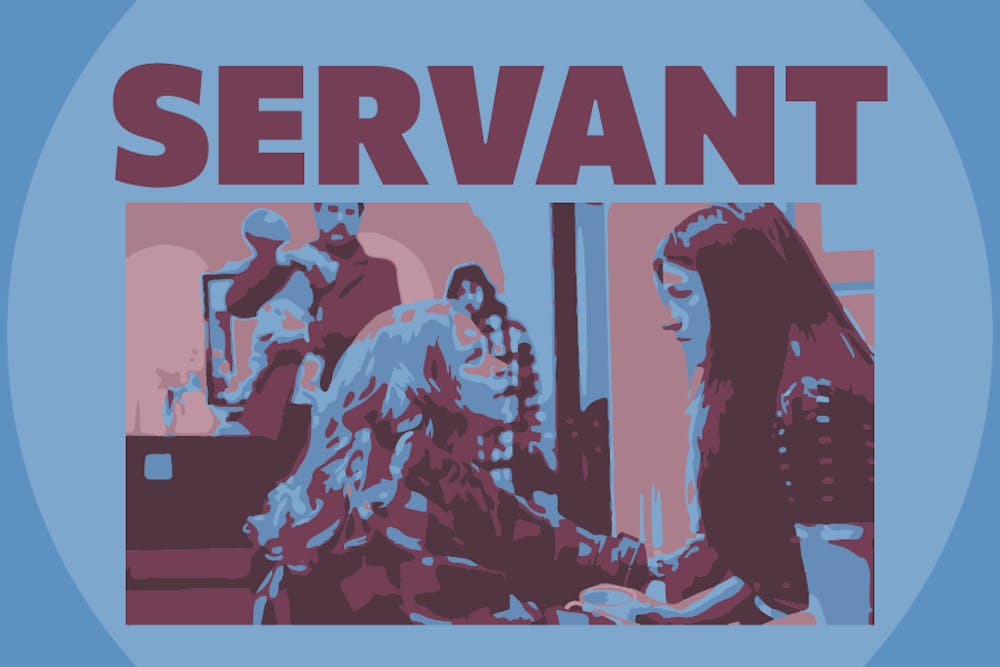When I first imagined attending an advanced screening, I anticipated long lines and crammed theaters. Press, celebrities, and dedicated movie–goers contend for a coveted seat, and a few unlucky individuals are turned away. Rather, when I attended an advanced screening of Apple TV’s Servant, I was hunched over my twelve–inch computer screen in pitch black. My best friend and I spoke animatedly, ready to decode the season three premiere. Despite the widely different reality compared to my expectations, there was a certain intimacy to it.
The Apple TV production sees Dorothy and Sean, a Philadelphia couple in the throes of grief, hire a nanny, Leanne, to look after a doll of their infant son, Jericho, who died at thirteen weeks; However, as the show unravels, Leanne’s presence brings about a myriad of questions and few answers as the deceased infant seemingly comes back to life. Season two delves into her past, as the cult members who raised her come to the fore, and season three seems to be following a similar direction. The first episode sees her try to overcome a vicious attack at the hands of her Aunt Josephine.
Poeticism spills out of every crack and crevice of Servant’s “Donkey,” the season premiere. Director M. Night Shyamalan's meticulous attention to detail and knack for supernatural plots is not only recognizable but brands the psychological thriller as a cinematic standout. Though I had my reservations following The Last Airbender and After Earth, Shyamalan consistently proves his aptitude for filmmaking with his meaningful choices behind the scenes. The episode’s color scheme is particularly prominent—the splashes of yellow and blue captured my usually–wavering attention from the outset. The moth motif throughout the episode is perplexing, but when the payoff arrives, as Leanne comes face to face with the corpse of Aunt Josephine, still tucked between the walls, it’s horrifically affecting. Likewise, the set design seems to reflect Leanne’s isolation and the cracks in the foundation of the Turner family—the core of the home, where she spends the majority of her time, is old–fashioned and dingy compared to the modern shared space. Every theory I developed is pure speculation; that said, there’s a certain beauty to trying to put the pieces together.
Where the show strays from pure horror (though there are moments that will make you jump), it leans full–tilt into the psychological. Though the manufactured family’s connection appears stronger than ever, Leanne’s paranoia and Dorothy’s fragile mental state seem to put both women on edge. The sparse humor throughout the show cuts through the tension like a knife, and whenever it crops up in a scene, the morbid signature only serves to enhance the show. Likewise, the main cast performances are nothing to ignore—Rupert Grint’s puzzled Julian and Lauren Ambrose’s high–maintenance performance as Dorothy, trying to manufacture some maternal instinct, are exceptional.
Whereas in prior seasons, the perspective camera work favored the Turner family, the season three premiere sees Leanne take over the narrative and frame. Nell Tiger Free laces every scene with paranoia, and her eyes speak volumes. There are times when the world loses focus behind her and the sound falters to white noise. The extreme close–ups and troubling score illuminate this frightening atmosphere.
Shot in Philadelphia, the single–setting show rarely sees Leanne stray from the home. Usually, the outside isn’t seen through more than a FaceTime call with the Turners or a brief television segment, making every action taken outside of it all the more substantial. In a behind–the–scenes clip, Shyamalan highlighted the moment that Leanne attempts to go outside for the first time after three months. As he cites Leanne’s Hitchcock–like paranoia, he illuminates the creative decisions meant to reflect it: the exploding sound effects, the crumbling building, the wide lens, and hard cuts. Each detail highlights the creative team’s dedication to the show.
The psychological thriller has never been my first choice of entertainment; I prefer far quieter television to Shyamalan's exaggerated realism. Yet where the show’s concept doesn’t initially hold my interest, Servant’s third season premiere wins it over with what is genuinely some of the best cinematography on television today. Every scene felt like a game, and I can’t wait to play again.

